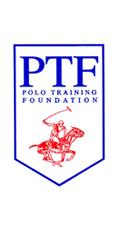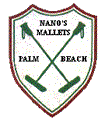In the traditional parlance of gift-giving, every milestone wedding anniversary calls for a particular theme. Tin or aluminum gifts signify 10 years, china 20 years, and silver 25
years. This year, then, marks the ruby anniversary for this publication’s wellspring as we
celebrate 40 years since the founding of POLO magazine.
The story of POLO begins with Polo
News and its charismatic founder, Ami
Shinitzky. Shinitzky was first introduced
to polo just a few years before founding
the magazine, in the winter of 1972.
Trapped inside an indoor riding facility
in Middleburg, Virginia for three days
and nights, Shinitzky took a turn
swinging the mallet on one of local polo
player, Steve Talbert’s green ponies.
In a farewell article before POLO’s
coverage transferred to POLO Players’
Edition, Tom Knight quotes Shinitzky
reminiscing, “I had never seen a polo
game, not even in the movies … and now
I am on this green pony, the mallet too
heavy, the footing too deep and the ball
underinflated. But that sweet sensation
of hitting the ball atop a moving horse
was instantly and irrevocably
intoxicating.”
A story familiar to many in the sport,
that first hit brought on a full-swing
addiction for Shinitzky, who became a
traveling equine dentist to pay for hay
and traveling the east-coast circuit.
However, a thinker as well as an athlete,
Shinitzky desired not just to play, but
also to read up on the more technical
aspects of the game. But apart from an
unsatisfactory Polo Newsletter
published by the USPA, there was not
much material available, especially since the end of the world wars.
So, that is how Shinitzky found
himself sitting next to then-chairman
Bill Ylvisaker at the USPA board of
governors meeting in September 1974,
pitching the notion of a new and serious
polo publication with himself as the
editor.
The USPA governors declined on the
basis that previous attempts at
publishing had failed. George Haas was
quoted in the June/July 1997 issue of
POLO as commenting on his role in the
matter as a circuit governor, “we were all
skeptical. We had had about three
[attempts at publishing] fail.”
While another man might have been
defeated, Shinitzky was unfazed and
determined to see his dream come to
fruition. After careful planning with his
then-wife Stephanie Burns, he came
back to the board in January 1975 in
Boca Raton, Florida, armed with a
detailed presentation, complete with
sketches and a logo. The revised plan
called for publishing the magazine at
his own risk, while the USPA would
discontinue its newsletter and use that
portion of its budget to purchase
subscriptions to the new publication.
The USPA governors unanimously
approved a one-year trial period for
Shinitzky’s proposal, and thus Polo News
was born. The first issue ran in May
1975, carrying articles about Royal Palm
Polo Club’s 20-goal league in Boca
Raton, Florida; an interview with polo
legend and former 10-goaler Stewart
Iglehart; tips for beginning players; an
opinion article about whether sideboards
are necessary; and a number of columns,
some of which still remain in PPE (polo
scene, letters, calendar), and others
which have disappeared (a polo
crossword puzzle, tips for club umpires,
polo ABCs, polo pony directory).
Some of this first issue’s features most
striking to a modern reader are its
advertisements. A number of prominent
polo names, recognizable still today,
purchased advertising space: Oxley polo
stables, Haas Financial Company (listing
George Haas and Peter Orthwein),
Bendabout Farms, Sugarbarb Farm
(listing Tony Coppola as manager), and
an advertisement for polo at the
Waikikian in Honolulu, which lists Fred
Dailey as its contact. Polo player and
restaurateur Norman Brinker’s Steak
and Ale chain held a prominent place on
the inside cover. Polospecific
ads included
someone selling a 1973
Hanover 14-horse
trailer and a stark
white ad which reads
“WANTED: a Mid-
States team is looking
for a three goaler
with his own horses
to play and help
win.” Still others
were simple best
wishes for the new
publication.
The first issue
was entirely blackand-
white, but the
second issue
introduced a bit
of color on the
cover, in the form
of the logo and a
border around
the page. More
and more color
crept into the
publication’s
pages from
issue to issue. One year later,
the magazine
was running full-color covers, with
modern, stylish color headings and even
a few full-color pages for feature stories.
In the September 1975 issue’s
“Keeping Up …” column, the editorial
staff announced, “POLO NEWS is soon
to change its name! Out of very many
ideas, POLO and POLO INT’L are the
two finalists. Which would you choose?
We’d like to know.” At least one reader
wrote in about his preference, published
the following month. Titled “It’s all in
the name,” John E. Siefkes of Wichita,
Kansas wrote, “Since you asked, I really
don’t mind Polo News. Of the two
finalists for the change, my preference
would be POLO. Since the emphasis is
on USA polo, INT’L would be at least
redundant, if not misleading.”
Siefkes was prescient, as readers of
the October/November 1975 issue found
the cover of their Polo News with a logo
simply reading POLO. The change in
name was registered on the masthead,
which read “incorporating polo news”
beneath the new
POLO logo, and in an
announcement reading “Polo
News is now POLO and will be
published monthly … We are
continuously working to make
POLO a better magazine and are
always receptive to your reactions
and suggestions.”
By the 10th year of the
publication, the continuous work
and improvements showed in
spades. The 1985 issues show the
magazine running 84 pages of
content, with advertisements for
familiar polo and equestrian
brands such as Palm Beach Polo,
Jackson Hole Horse Emporium
and Tackeria running alongside
high-end, luxury products such as Rolex,
Glenlivet, Piaget, Bushnell, BMW and
Ferrari.
The May 1985 cover, celebrating the
10th anniversary, featured an original
polo print by superstar pop-artist Andy
Warhol. The issue also featured the
results of a study that looked at the polo
swing using state-of-the-art technology.
“The High-Tech Swing” story explained
how the magazine set out to better
understand the basic polo strokes using
computer technology. After finding a
company to underwrite the project, and
hiring the world-renowned Coto
Research Center, the first
study took place at Palm
Beach Polo and Country
Club. The study looked at
the swings of Podger el-
Effendi (8 goals at the time),
Memo Gracida (then 10
goals) and Alan Connell
(then 1 goal).
In his reflections on the
first 10 years, Shinitzky
detailed his thinking
about the place of POLO
in the polo world.
"We have assumed the
role of the sport’s
conscience,” he
writes, “raising a cry
about issues that
compromised the
virtues and
aspirations of the
sport. This form
has now
broadened, and
even more opinions are now heard.”
Occupying a space Shinitzky described
then as “somewhat schizophrenic,”
POLO was at once the official organ of
the USPA, while also maintaining itself
as the mirror to the polo world,
reflecting back its virtues and vices,
warts and all.
As Shinitzky rightly identified in his
reflection, POLO was successful not just
because it was a superb magazine that
punched far above its weight—it was—but
also because it was founded at just the
right moment, just as interest and
activity in the sport began to surge.
For example, in 1974—the same
year Shinitzky first pitched the
publication to the USPA—only
three teams competed in the U.S.
Open championship. By 1977, 13
teams had entered the
competition, and the handicap
level of the championship was
raised.
At the same time, wealthy
patrons were opening now
legendary hotspots for polo, such
as Retama in Texas and Palm
Beach Polo in Florida. POLO’s
journalistic excellence and high
standards were there at the right
time to record this high point in polo history, just as the
sport began a period of flourishing.
In 1986, Shinitzky introduced the
Polo Excellence Awards, recognizing the
best in the sport, including Player of the
Year, Young Player of the Year,
Intercollegiate Player of the Year,
Women Player of the Year, Arena Player
of the Year and Amateur Player of the
Year. That first year, the black-tie awards
presentation was held at the Royal
Poinciana Playhouse in Palm Beach,
Florida. Winners received a 12-inch
bronze “Tommy,” a likeness of polo
immortal Tommy Hitchcock Jr. before
700 guest and VIPs. The evening was
hosted by actors William Devane and
Jane Seymour.
Despite its success, the polo
community failed to support the lavish
presentation ceremony the following
year. The awards continued to be
presented, in a more casual setting, until
2005.
In the 1980s, one can see this high
crest breaking as the luxury brands fade
from the pages of POLO and are
replaced with more conventional trade
advertisements for
Argentine tack, mallets,
trailers, horses, veterinary
and grooming products,
polo clubs and western
clothes. The fat years
were over, but the
magazine’s content was
as rich and as detailed as
ever, covering the
biggest names and
events in polo in the
high journalistic detail
for which the magazine
was always known.
If the advertisements
do not speak to the
magazine’s success and
popularity among the
polo community, then
certainly its reception
throughout the years
must. In Shinitzky’s
last issue with POLO,
22 years later, a
number of polo
notables chimed in to reflect on the legacy
of POLO. Clint Nangle is quoted, “[the
magazine] brought the
polo community all
together in some way … we
were all waiting for it to
arrive every month.”
Likewise, Jack Oxley
remarked, “Players and
members felt a personal
identification with it and
still do. It’s their sport’s
publication. Ami and Polo
have been the articulate,
printed voice of polo.”
Former USPA
Communications
Committee Chairman
Richard Latham had a
different perspective on
reflection. “By and large
it’s a pretty good
publication,” he admitted,
but “in fact, it should
have been called Ami
Shinitzky Forum instead
of Polo magazine … The
USPA’s views were not
always represented or
represented right.”
However, he conceded, “Ami was a goad
for the good.”
In March 1995, Shinitzky was looking
to move on. He hired Peter Rizzo as
Associate Publisher and Gwen Rizzo as
Editor-at-Large and schooled them in
publishing a magazine. Peter Rizzo had
been a contributor dating back to the
first issues when he was attending
George Washington University. Later
that year, in November 1995, Peter took
over as Editor and Publisher.
Shinitzky’s involvement with the
magazine came to a close in 1997, when
John Goodman’s Westchester Media
bought the rights to POLO. Under
Westchester Media, POLO was
transformed from a magazine for polo
insiders into an upscale lifestyle
magazine with only a garnish of polo—
less for the people on horseback as for
the people under big hats in the stands.
POLO in its new form was published
from October 1997 until October 1999,
when, after lengthy court battles with
Polo Ralph Lauren, it closed its doors.
While POLO became the
lifestyle magazine, a monthly
players’ edition carried the torch
from Shinitzky’s original
magazine. In the first issue of
POLO Players’ Edition, Peter
Rizzo explains, “For you (and
me!) there will be a “Players’
Edition,” which will be much the
same as the POLO magazine of
recent years. A quick look at our
masthead and table of contents
will confirm that much of the
editorial content and format will
be carried over. Our mission
remains to chronicle the sport,
providing the polo player an
inside look at all the action and
drama on the field, as well as an
insider view behind the scenes.”
The first issue of Polo Players’
Edition was printed in September
1997, with Peter as Publisher and
Gwen as Editor. Gwen was
promoted to Editor and Associate
Publisher in August 2002 and finally to
Editor and Publisher in June 2004.
Today, the magazine is the longest
running polo publication worldwide in
the history of the sport. It continues to
be distributed in some 40-plus countries
and is the official publication of the
United States Polo Association.
In 2012, the USPA purchased
the naming rights to POLO and
Polo Players’ Edition from
Westchester Media.
Though some aspects of the
magazine are the same after all
these years, it now contains full
color pages from cover to cover
and is available in a digital
edition.
The magazine is unique in
that, by-and-large, the stories are
written by active polo players.
Rather than focusing only on the
glitz and glamour associated with
just a very small segment of the
sport, it covers all aspects of the
sport from low goal to high goal.
In addition to chronicling
tournament victories, births, and
deaths, it continues to include
useful articles on horse care,
field care, youth polo, polo news,
as well as how-to articles and indepth
articles on major events,
players, clubs and more.
Forty years later, the magazine is still
undeniably a magazine for polo players,
by polo players.
By Stephen Rizzo |









